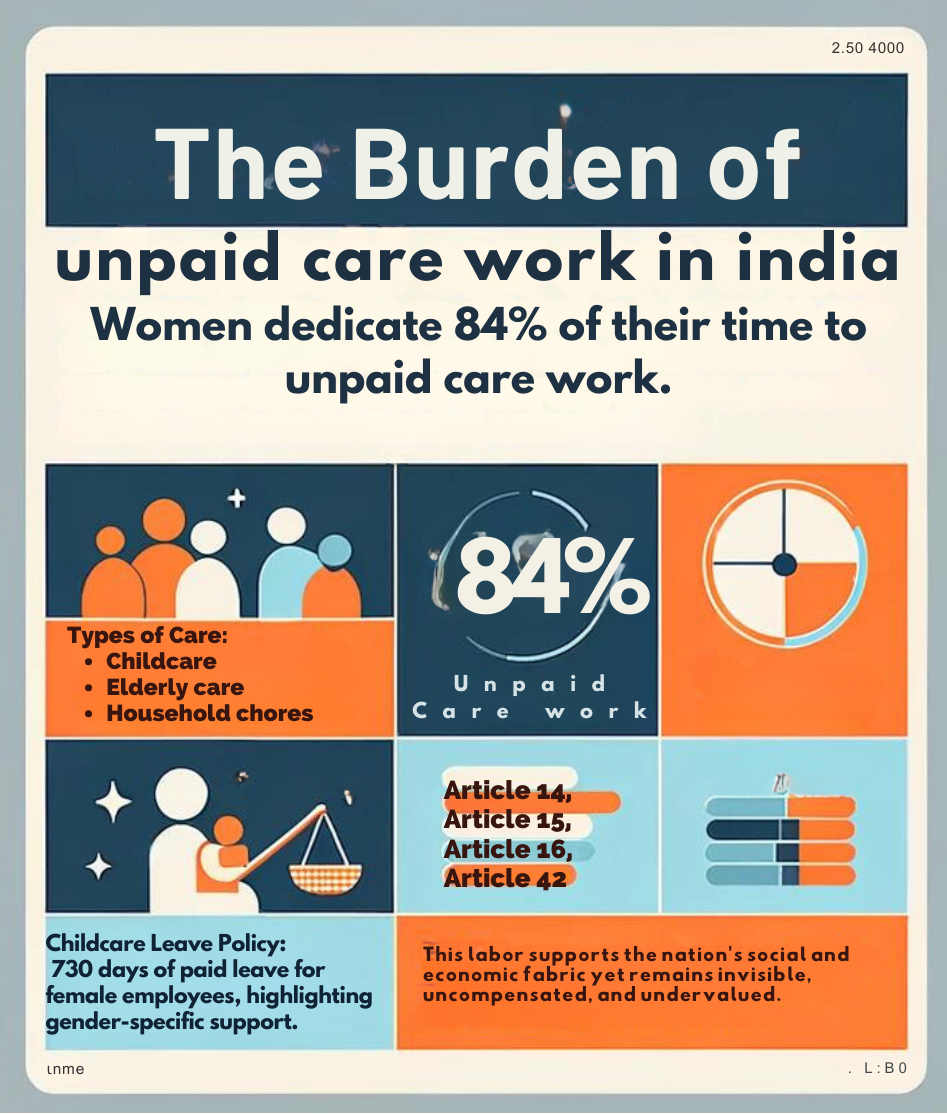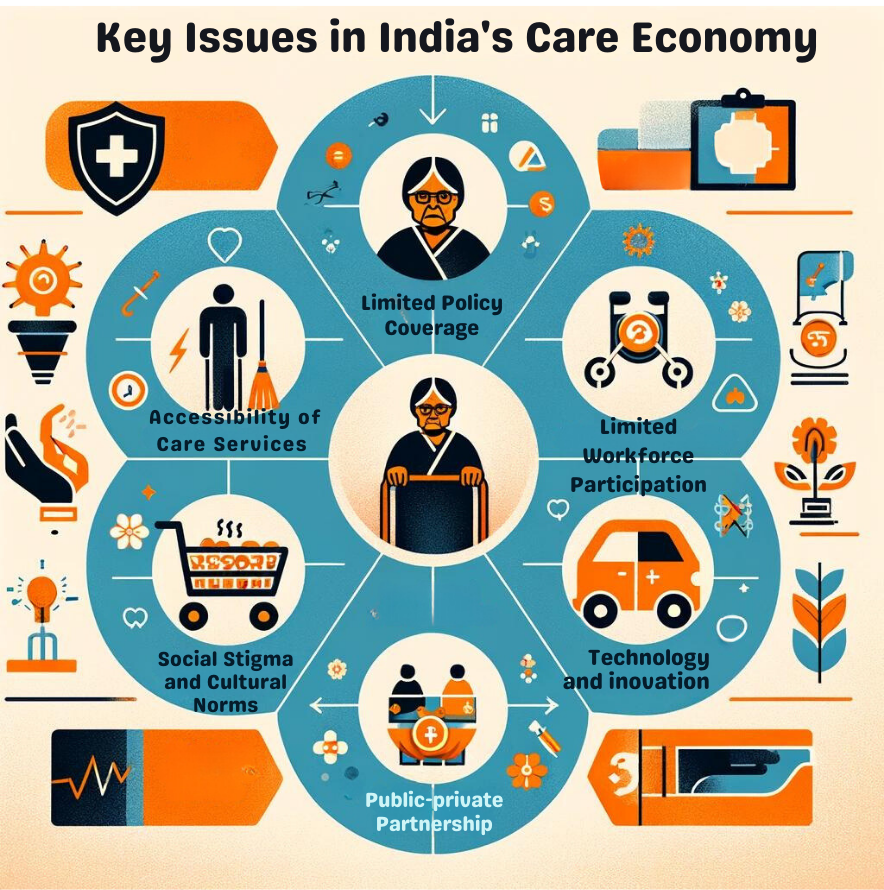Introduction:
In a groundbreaking move, the Supreme Court of India recently underscored the importance of childcare leave (CCL), marking a significant step towards acknowledging the immense, yet often invisible, contributions of women to the nation through unpaid care work. This editorial, inspired by the discourse on “Mom, baby and us: Who takes care of the children?” published in The Indian Express, delves into the complexities of India’s care economy. It highlights the critical role of unpaid care work, predominantly shouldered by women, and the pressing need for societal and policy reforms to recognise, value, and equitably distribute this form of labor. As we navigate through the multifaceted dimensions of childcare and the broader care economy, this discussion opens up crucial conversations about gender equality, social justice, and sustainable development.
Origin of the Article:
This editorial is based on “Mom, baby and us: Who takes care of the children?” which was published in The Indian Express on April 30, 2024. The article examines the multidimensional aspects of unpaid care work in India, emphasizing the need for a valued, inclusive, and just care economy.
Relevancy for UPSC Students:
Understanding the dynamics of the care economy is crucial for UPSC aspirants, as it intersects with various segments of the UPSC syllabus, including Indian Society, Women’s Issues, and Governance. This topic not only enhances awareness about the structural inequalities within the economy but also equips students with insights into potential policy reforms. Grasping the intricacies of the care economy and its impact on gender equality and social justice prepares candidates for both the Prelims and Mains, fostering a comprehensive understanding of India’s socio-economic fabric.
Why in News:
The Supreme Court’s recent ruling on Childcare Leave (CCL) and the editorial’s focus on India’s care economy underscore its pertinence for UPSC civil services exam aspirants. This topic intertwines with GS Paper – 2’s themes like the role of women in society, social justice, and governance, reflecting on constitutional provisions safeguarding working women’s rights. The care economy, emphasizing unpaid care work’s value, directly relates to questions on gender equality and women’s economic participation, mirroring the UPSC’s trend of probing aspirants on social issues with significant policy implications. The editorial’s exploration of policy gaps, societal norms, and potential reforms provides a comprehensive understanding, encouraging critical thinking on how policy innovations could address gender disparities in India’s workforce.
Introduction to Care Economy in India
Supreme Court Ruling on Childcare Leave
The Supreme Court of India recently underscored the constitutional rights of working women by declaring the denial of Childcare Leave (CCL) to a government employee as unconstitutional. This landmark ruling not only champions the rights of working mothers but also sets a precedent that acknowledges the critical role of childcare in fostering a supportive work environment.
Unpaid Care Work by Women
In India, the contribution of women to unpaid care work is monumental, with women dedicating 84% of their time to such endeavors. This staggering statistic illuminates the vast, yet often invisible, labor that women contribute to the economy, highlighting a significant area of gender inequality that demands attention and action.
Constitutional Provisions Related to Working Women in India

Article 14
Article 14 of the Indian Constitution, advocating for the Right to Equality, serves as a cornerstone for ensuring that working women are treated on par with their male counterparts. This provision is instrumental in combating gender discrimination in the workplace, promoting an ethos of equality and fairness.
Article 15
Article 15’s prohibition of discrimination on the grounds of sex is pivotal in safeguarding women’s rights in public employment. By mandating equal treatment and opportunities, this article plays a critical role in paving the way for gender equality in the workforce.
Article 16
Equality of opportunity in matters of public employment, as guaranteed by Article 16, fortifies the legal framework protecting women from gender-based discrimination in job opportunities, ensuring a level playing field in the public sector.
Article 39
Article 39 champions the cause of equal pay for equal work, among other principles, underlining the state’s commitment to fostering equitable working conditions and livelihood opportunities for both men and women, which is crucial for achieving gender parity in the workplace.
Article 42
By directing the state to ensure just and humane conditions of work and maternity relief, Article 42 acknowledges the unique challenges faced by working women, particularly in the context of maternity, and calls for supportive measures to address these challenges.
Central Government’s CCL Policy
The Central Government’s CCL Policy is a progressive step towards recognizing the caregiving responsibilities of female employees, offering them substantial paid leave to care for their children. This policy not only acknowledges the dual roles of women as professionals and caregivers but also opens avenues for single fathers, promoting a more inclusive approach to parental leave.
Sustainable Development Goal for Women (SDG 5)
SDG 5’s focus on gender equality and women’s empowerment is crucial in addressing the disparities in the care economy. By advocating for the recognition of unpaid care work and promoting shared domestic responsibilities, SDG 5 aligns with the broader goal of achieving gender equality and empowering all women and girls, which is fundamental for sustainable development.
What is a Care Economy?
The care economy, encompassing both paid and unpaid care work, is vital for the well-being and sustenance of society. Despite its significance, this sector remains largely unacknowledged and undervalued, pointing to the need for a paradigm shift in how care work is perceived and compensated.
Difference from Monetised Economy
Unlike the monetized economy, which operates on market principles and monetary transactions, the care economy thrives on the unpaid and often unrecognized labor that supports the social fabric. This contrast highlights the need for integrating care work into economic valuations and policies.
History and Related Terminologies
The evolution of the care economy, propelled by feminist economists and landmark initiatives like the Beijing Platform for Action, has brought to light the indispensable role of care work. The distinction between paid and unpaid care work, along with the introduction of terms such as the Care Diamond, underscores the complexity and multifaceted nature of care in our society.
Key Issues Related to the Care Economy in India

Limited Policy Coverage
The existing policies in India, including the Maternity Benefit Act, often fall short in catering to the vast majority of women engaged in unpaid care work, especially those in the informal sector, highlighting a critical gap in policy coverage and support.
Limited Workforce Participation
The disproportionate burden of care work on women significantly restricts their participation in the formal workforce, underscoring a major barrier to gender equality and economic empowerment for women in India.
Lack of Accessibility of Care Services
The scarcity of affordable and quality care services in India exacerbates the challenge of balancing work and caregiving responsibilities, particularly for low-income families, indicating a pressing need for investment in care infrastructure.
Social Stigma and Cultural Norms
Deep-rooted societal norms and stigmas perpetuate the gendered distribution of care work, impeding the progress towards a more equitable sharing of caregiving responsibilities between men and women.
Way Forward
The 3R Framework
Employing the 3R Framework to Recognize, Reduce, and Redistribute childcare responsibilities is essential for alleviating the burden on mothers and fostering a more equitable distribution of care work.
Skill Recognition and Micro-credentials
Recognizing the skills acquired through unpaid care work and providing micro-credentials can enhance the employability and acknowledgment of caregivers, facilitating their integration into the formal economy.
Increasing Investment in Care Economy
Significant investment in the care economy is imperative for generating employment opportunities, particularly for women, and for acknowledging the economic value of care work, aligning with global best practices and recommendations.
Technology and Innovation
Leveraging technology to support caregivers and improve access to care services can play a transformative role in modernizing and enhancing the care economy.
Public-Private Partnerships
Fostering public-private partnerships to develop innovative and sustainable care solutions is crucial for expanding access to affordable care services and supporting the care economy at large.
The multifaceted challenges and opportunities within India’s care economy demand concerted efforts across societal, policy, and economic dimensions. By recognizing the value of care work, addressing policy gaps, and promoting gender equality in both the workforce and domestic spheres, India can pave the way for a more inclusive, equitable, and just care economy.
Conclusion
In the journey towards gender equality and empowerment, recognizing, valuing, and redistributing unpaid care work emerges as a critical frontier. The Supreme Court ruling underscores a momentous shift towards acknowledging the invisible labor that sustains our society. For UPSC aspirants, this editorial not only highlights the multifaceted challenges within India’s care economy but also invites innovative thought on integrating care work into the formal economy. As future administrators and policymakers, you are poised to drive transformative change, ensuring that care work is no longer a silent contributor but a recognized pillar of our economic and social fabric. Let this insight inspire you to envision policies and frameworks that uplift the care economy, paving the way for a more inclusive and equitable society.


